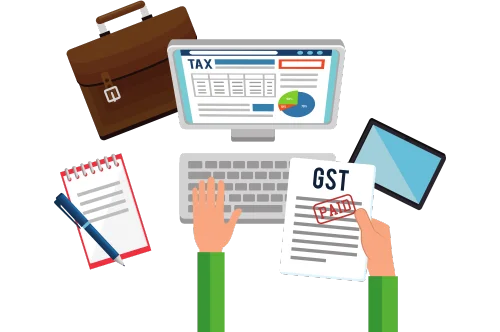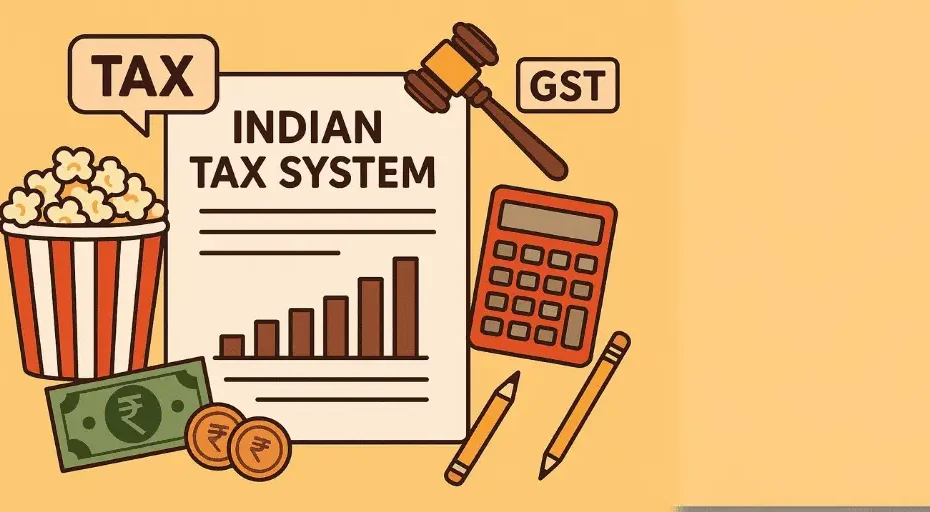Popcorn to Pencils: The GST Burden on Everyday Essentials
The Indian tax system has undergone significant reforms in recent years, with the Goods and Services Tax (GST) being its most transformative move. Billed as a “One Nation, One Tax” initiative, GST was intended to simplify indirect taxation. While it has indeed streamlined tax processes and improved compliance, its impact on everyday essentials has raised serious questions. From popcorn at the movies to pencils in school bags, the GST regime has taxed items considered basic or essential to the average Indian household.
In this blog, we explore how the Indian tax system, specifically GST, is affecting the affordability of common goods, and why it may be time to re-evaluate the priorities built into this system.
Understanding the Indian Tax System and GST
The Indian tax system is divided into two broad categories: direct and indirect taxes. Direct taxes include income tax, corporate tax, etc., while indirect taxes include GST, customs duty, and excise. GST, implemented in July 2017, merged multiple indirect taxes into a single tax structure across the country.
GST is levied at multiple slab rates — 0%, 5%, 12%, 18%, and 28% — depending on the nature of goods and services. While this was done to distribute the tax burden more equitably, it has ironically created confusion and disproportionate pricing across categories, especially when it comes to essentials.
The Hidden Price of Popcorn
Let’s begin with a popular example: popcorn. A tub of popcorn at a multiplex is taxed at 18% GST, making it more expensive than some processed foods or even certain luxury items. The Indian tax system, in this case, does not differentiate between a luxury snack at a theatre and a packet sold by a street vendor. The one-size-fits-all logic of GST slabs doesn’t consider affordability for the average consumer.
This becomes even more critical when we examine how GST is applied to food served in restaurants. A restaurant with air conditioning is taxed at 18%, while a non-AC one is taxed at 5%. This arbitrary distinction in the Indian tax system has created disparities that defy logic and fairness.
Pencils, Notebooks, and School Supplies: A Tax on Learning?
School-going children are among the most silent sufferers of the GST structure. Items like pencils, erasers, notebooks, sharpeners, and even school bags are taxed under various GST slabs ranging from 5% to 18%. For instance, pencils attract 12% GST while sharpeners are taxed at 18%. That means families pay more tax on their child’s education essentials than they would on sweets or biscuits in some cases.
The Indian tax system was expected to reduce costs and promote fairness, especially for the middle class and lower-income groups. However, taxing education-related items under mid to high GST slabs indicates a serious oversight. This burden directly affects the affordability of schooling in a country where education is still a luxury for many.
The Middle-Class Dilemma
The Indian middle class, already grappling with inflation and stagnant wages, bears the brunt of these tax rates. Unlike the wealthier class, they can’t afford to ignore rising prices, and unlike the lower-income group, they aren’t eligible for subsidies or welfare. The Indian tax system fails to acknowledge this gray area where most Indian households exist.
Daily-use products like toothpaste (18% GST), soaps (18%), washing powder (18%), and even sanitary napkins (12%) add to monthly household expenses. The impact is cumulative. Every extra rupee paid as tax eats into savings, reducing the disposable income available for education, healthcare, or even basic entertainment.
GST Slabs: A System Needing Reform
One of the biggest criticisms of the Indian tax system under GST is the complexity of the slab system. While the intention was to create clarity and uniformity, it has ended up adding confusion and unintended burdens. Why are pencils taxed higher than printed books? Why is a movie snack taxed higher than a restaurant meal in some cases?
A fairer Indian tax system should reassess the current GST slabs and realign them with necessity, accessibility, and socio-economic impact. Essentials — especially those related to education, health, and hygiene — should be placed under the zero or 5% category. Uniformity must not come at the cost of logic and empathy.
GST and Small Businesses
Another unintended consequence of the GST framework in the Indian tax system is its impact on small vendors and businesses. For instance, a small stationery store owner now has to comply with e-invoicing and tax filings that were previously only expected of large corporations. Compliance has become burdensome, especially for those who lack digital infrastructure or financial literacy.
Additionally, GST has increased costs for small retailers who deal in low-margin products like pens and erasers. Since tax is levied at every point in the supply chain, these costs are eventually passed on to the end consumer. Once again, the Indian tax system has created a structure where the burden trickles down to the common man.
Are There Alternatives?
Some economists suggest implementing a dual-rate GST structure: one for essentials (at a lower rate) and another for luxury or non-essential goods. This could simplify compliance and make the system more equitable. Others advocate for more frequent updates to GST rates based on inflation and public necessity, rather than sticking to a rigid tax structure.
While the Indian tax system aims to increase government revenue and simplify collection, it must also remain flexible and responsive to societal needs. It should not treat popcorn and pencils as economic equals.
The Way Forward
The promise of the Indian tax system, particularly under GST, was to make taxation transparent, simple, and fair. However, when essentials are taxed at the same or higher rates than discretionary items, the system veers off-course.
It is time for policymakers to:
Reassess GST slabs based on necessity.
Reduce the tax burden on education and hygiene products.
Offer relief to small vendors through simplified compliance mechanisms.
Ensure regular audits and feedback loops to keep the Indian tax system citizen-centric.
A reformed Indian tax system would acknowledge that small changes — like lowering the tax on a pencil or a tub of popcorn — can have significant social and economic implications. After all, taxation is not just about revenue, but about the values a nation chooses to prioritize.
Conclusion
From popcorn to pencils, the everyday consumer continues to pay more than their fair share under the current GST regime. While the Indian tax system has made significant strides in modernization and digitalization, its fairness and sensitivity toward essential goods remain in question.
To build a more equitable and inclusive India, the Indian tax system must evolve — not just in structure, but in spirit.
Our GST Services

All E-commerce Tax services
E-commerce tax services help online sellers navigate GST registration, compliance, return filing, TCS management, tax planning, and audits, ensuring efficient tax management and legal compliance.

GST Filing
GST filing is the process of submitting tax returns to the government, detailing sales, purchases, and taxes paid or collected, ensuring compliance with GST laws.

GST Registration
GST registration is the process where businesses obtain a GSTIN from the government, allowing them to collect taxes, claim input tax credits, and comply with GST laws.





